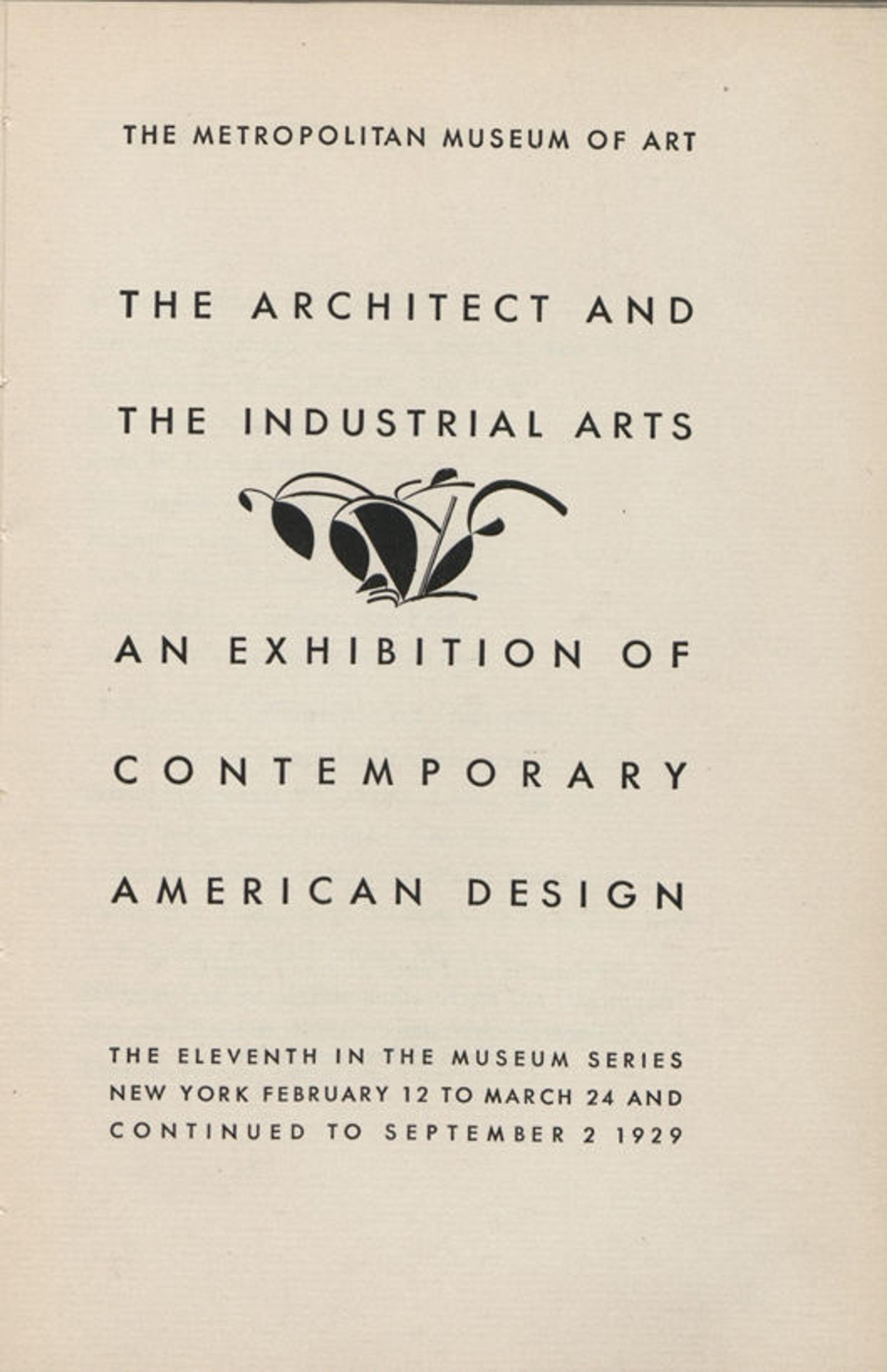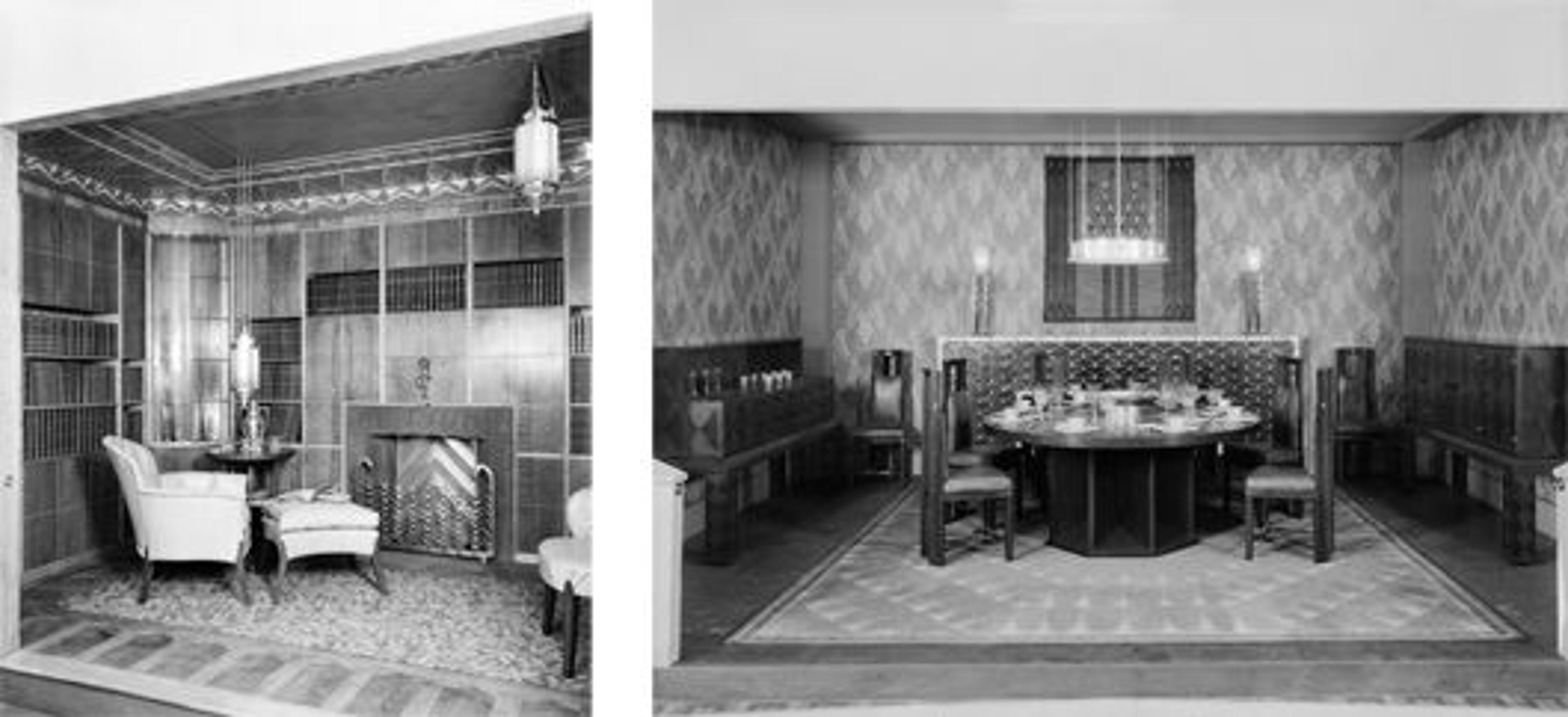«When the Museum Library took its first steps toward digitizing rare materials from its collection over two years ago, one of the first groups of items we selected for scanning was a set of pamphlets that accompanied a landmark series of American industrial arts exhibitions from 1917 to 1940.» Organized at the Museum by Richard F. Bach (1887–1968), the exhibitions featured the work of contemporary American industrial designers and manufacturers. In addition to the pamphlets, we digitized related circulars that were sent to potential exhibitors, as well as other publications by Bach and his contemporaries.
Antoniette Guglielmo has spent the past year researching the pivotal role that Bach and the Museum played in the history of American industrial design, while preparing her forthcoming book on the subject. In doing so, she has made extensive use of the Met's libraries, archives, and image collections. We asked her to share some background on these materials, and we are grateful to her for giving broader context to this small but important digital collection.
—Robyn Fleming, Assistant Museum Librarian, Thomas J. Watson Library
Good Design, Good Taste: Richard F. Bach and the Industrial Arts Exhibitions

The architect and the industrial arts; an exhibition of contemporary American design (detail of title page). New York: The Metropolitan Museum of Art, 1929. Thomas J. Watson Library (159.4 N486 1929)
In May 1927, the art critic at The New Yorker proclaimed that Richard F. Bach had "affected American life second only to Henry Ford." This designation speaks to Bach's outstanding contributions toward promoting art in industry, a role he championed for thirty-four years at The Metropolitan Museum of Art, holding positions as Associate in Industrial Arts (1918–1929), Director of Industrial Relations (1929–1941), Dean of Education and Extension (1941–1949), and Consultant in Industrial Arts (1949–1952). Bach's career and his influence on the industrial arts, largely overlooked by historians, were the focus of my doctoral dissertation. As a postdoctoral fellow, I have spent the past year examining more closely the Metropolitan's role in fostering modern American design. The libraries' digitized collections have been invaluable in my research.
Bach's work at the Metropolitan involved strengthening the ties between art and industry to boost the economic climate of the United States, improve American design, and elevate public taste. The fusion of art and industry that Bach promoted at the Metropolitan may actually be traced back to the original charter of 1870, which called for the "application of arts to manufacture and practical life" and "furnishing popular instruction." In 1914 the Museum began using objects from the collections to train department-store workers in the principles of good design, which informed their selection and marketing of merchandise. In 1917, these efforts were bolstered by a newly created Department of Industrial Relations. Leading this department, Bach developed extensive relationships with industrial designers, manufacturers, department stores, and professional organizations.
A prolific writer and lecturer, Bach promoted the concepts of good design and good taste in The Metropolitan Museum of Art Bulletin, as well as in trade publications and the press. Elevating public taste was a necessity for consumers, he argued, because Americans had become vulnerable to purchasing items of poor quality due to shortages during World War I. He encouraged manufacturers to awaken to this opportunity by producing industrial art—including furniture, textiles, and other household items—bearing the trademark, "American-made and designed." Bach's activities aggressively positioned the Metropolitan Museum as the national vehicle for the refinement of American public taste. As he exclaimed in the Bulletin in 1920: "The Metropolitan Museum has a practical or trade value, it is an adjunct of factory, shop, and designing room. It is a working collection, a museum militant, and rapidly taking its rightful place as a workbench of American taste."

Richard F. Bach, Museums and the Industrial World (detail of page 1). New York: The Metropolitan Museum of Art, 1926. Thomas J. Watson Library (108.1N48 M578)
Among Bach's projects was the publication of the Museum's series of industrial art monographs. His monograph Museums and the Industrial World, the first in a series of four, envisioned an industrial art museum of the future as a utopian place for cultivating taste and promoting art in industry. He described this opportunity: "In the industrial arts and in the types of thought which guide or control them, which serve or contribute to them, there is fertile virgin soil for the museum of art, offering direct as well as subtle lines of influence by which, properly used, museums may bind themselves forever to the most intimate feelings of the people, reaching them through their home furnishings, their utensils, their objects of personal adornment, their clothing."
Most important, Bach organized a series of fifteen annual exhibitions of contemporary American industrial art held at the Metropolitan from 1917 to 1940. These "annuals" displayed exemplars of good design, encompassing home furnishings, textiles, rugs, jewelry, ceramics, glass, metalwork, drawings, and lighting while also featuring new works that were specifically created for each exhibition.

Installation view of The Museum of Art as Laboratory: Sixth Exhibition of American Industrial Art, 1922
The annuals varied in size and scope, method of installation, and popularity. The early exhibitions, from 1917 to 1923, displayed works by manufacturers and designers that had been inspired by the Museum's collections, which was a mandatory criterion for inclusion. Over time, the exhibitions evolved in response to changing social, artistic, and economic agendas. From 1924 to 1940, the criteria for participation expanded to include works that were American made and designed, but not solely the result of museum study. The most popular annuals—in 1929, 1934, and 1940—were staged with complete room settings and created in collaboration with prominent architects and designers of the day.
The eleventh annual, The Architect and the Industrial Arts, held in 1929, was a blockbuster, and its run was extended due to popular interest. Final attendance, at over 186,000, topped all previous industrial art shows at the Museum. Featuring an American Art Deco style, it included room ensembles created by Raymond Hood, Ely Jacques Kahn, Ralph T. Walker, Eliel Saarinen, and Joseph Urban, among others. More than 150 manufacturers participated in the production of the various rooms. The architects and designers are listed in the catalogue, which also includes descriptions and images of the glistening Art Deco settings.

Left: Ralph T. Walker, "Man's Study for a Country House." Right: Eliel Saarinen, "Dining Room." Both from The Architect and the Industrial Arts, 1929
With nationalist pride, Henry Watson Kent, longtime Secretary at the Museum, proclaimed The Architect and the Industrial Arts a success for America. He wrote in the Bulletin in April 1929 that the exhibition "shows conclusively that, given the authority of first-class training and understanding of the problem, the American designer, working for or with the manufacturer, whose power to compete with European manufacturers is undoubted and clearly demonstrated, should be able to compete successfully with his foreign rival." By the time of the last annual in 1940, the series in totality served as a strong document of the progress in American design.
Through Bach's campaign to encourage good design and good taste, the Metropolitan led the way in promoting contemporary American industrial art in the early twentieth century. Today, the digitization of the libraries' collections both preserves and makes accessible this innovative chapter in the Museum's history.
Further Reading
Guglielmo, Antoniette M. 2012. "The Metropolitan Museum of Art as an Adjunct of Factory: Richard F. Bach and the Resolution Between Gilman's Temple and Dana's Department Store." Curator: The Museum Journal 55/2: 203–14.
Miller, R. Craig. 1990. Modern Design in the Metropolitan Museum of Art, 1890–1990. New York: Metropolitan Museum of Art and Harry N. Abrams Publishers.